This post was originally published in 2023 and updated in 2025.
The first piece of alpaca clothing I owned was a pair of alpaca socks. From the moment I put them on, I fell in love. My husband bought them for me as a gift and little did he know, I was going to become a huge fan and advocate of alpaca products.
Move forward a few years and our farm is producing its own alpaca socks knit from Michigan fiber and made in the USA. We’ve come a long way from the moment I put on my first pair. As we migrated from consumer to alpaca farmer to sock producer, I’ve learned a lot about alpaca fiber, manufacturing alpaca socks, and helping our customers find the best socks for their individual needs and wants.
In today’s post, I’d like to walk through the amazing properties of alpaca fiber, why it’s a great material for socks, and what you should know about purchasing your first pair of alpaca socks.
Why People Love Alpaca Fiber
Alpaca socks are very popular, and it is not by accident. Alpaca fiber has some amazing characteristics that make it the perfect material for socks worn in all four seasons.
Here is why alpaca fiber is the perfect material for socks:
- Warmth– Alpaca is a natural wool similar to traditional sheep’s wool, however, alpaca offers a better insulation value. It is estimated that alpaca is three times warmer than sheep’s wool.
- Hypoallergenic– Alpaca does not contain lanolin, so it is a naturally hypoallergenic fiber. While this won’t matter to everyone, it does matter to people like me and my son. We are both very allergic to sheep’s wool and we cannot wear even a blended sheep’s wool product for more than a few minutes. This is not the case with alpaca products. Sheep’s wool turns my head red and makes me itch right after I put it on. And yet with alpaca products, I can wear them all day without issue. No redness and no itching.
- Wicks away moisture– Another cool property of alpaca fiber is its ability to wick moisture away from the skin. This makes it a favorite material for kids’ sports, skiing, hunting, and outside work environments.
- Reduces odor– If stinky feet are a problem you deal with, alpaca socks will be your new best friend because alpaca fiber wicks moisture away from the skin which greatly reduces opportunities for smelly feet and odors.
- Antimicrobial – Like other natural wools, alpaca is antimicrobial. This is good for your skin and definitely great for your feet!
- Water repellant– My silly alpacas lounge around outside on rainy days and snowy nights. They have 24/7 access to shelter but often choose to ignore it. They can stay outside in wet weather because they don’t really feel the water. Their fiber naturally repels the water, and they just don’t realize it’s as wet outside as it is. While I cannot say your alpaca socks will let you sleep outside in the snow, I can say they will help protect your skin from water.
- Fire-resistant– Alpaca fiber is naturally fire-resistant. Note I didn’t say fireproof, I said resistant. The fiber has a natural ability to slow the ignition of flames and prevent flames from growing. This fire-resistant property makes it an awesome option for firefighters, paramedics, utility line workers, and electricians.
- Soft to the touch– Alpaca fiber has a very low micron count, and this makes it very soft. In addition, unlike a traditional sheep’s wool, alpaca fibers have small scales which aid in producing a higher comfort factor. This makes the material naturally soft and great for extended wearing.
- Sun protection– In the spring and summer I frequently see a pasture full of alpacas sleeping in the sun. They appear dead, but in reality, they are just soaking up the warmth of the sun’s rays. Why would a very furry alpaca voluntarily sunbathe? Because the same fiber qualities that insulate them from cold helps protect them from the sun’s heat. I can touch a sunbathing alpaca and feel the warmth on the tip of their coat, and yet, they don’t feel anything at all because their fiber is insulating them from the sun’s heat. It is this property that allows alpaca socks to be worn all year round.
- Durability– I wish I could convey what my alpacas look like in the spring months. As the weather warms in Northern Michigan, our alpacas will roll around in the grass, dirt, and anything else they can find. All of this gets into their fiber, and they look like a complete mess. Do I stress about their lovely fiber being ruined? Nope. Not at all. I know the wind will soon blow it all out, and once again, my beloved furballs will look like the magical creatures they are. It’s this durability of fiber that lends itself to a great, long-lasting product in clothing such as socks, sweaters, and hats or other cool products like rugs and horse saddle pads.
- Biodegradable – Similar to other natural wools, alpaca will decompose in six months.
- Sustainable – Alpacas are very soft on their environment. They nibble on grass and don’t pull it up like other livestock. Alpacas also have low water requirements and they are extremely efficient eaters, which makes a low maintenance type of animal.
Medical Conditions Alpaca Socks Help
I am going to speak from first-hand experience. I am a type one diabetic who also struggles with Raynaud’s disease. I know exactly why alpaca socks are perfect for people who suffer from conditions like diabetes or Raynaud’s syndrome.
Here is why alpaca is perfect for both these conditions:
- Diabetes– The alpaca industry uses high-quality fiber to produce loose fitting, therapeutic socks for diabetics. These diabetic socks are non-binding, not restrictive, and provide extreme comfort for sensitive feet. These relaxed alpaca socks will offer breathable wear that helps support healthy feet for diabetics. And better yet, they look like regular old socks.
- Raynaud’s– Raynaud’s disease causes my fingers and toes to turn white in cold elements. This is not just a visible issue. My fingers and toes hurt when I have an episode. In Raynaud’s disease, smaller arteries that supply blood to your skin become narrow, limiting blood flow to affected areas like my fingers or toes. This loss of blood flow is what causes the white coloring and pain. I live in Northern Michigan and in the depths of our winter, so I never wanted to go outside. My fingers and toes would hurt too much to enjoy it. Then I discovered alpaca clothing. Alpaca socks and gloves became my hero. My Raynaud’s episodes are few and far between now. When my husband comes in from chores, he’ll say it’s really cold outside today, so make sure you wear your alpaca socks. He knows they make a difference, and he knows they’ve helped me finally enjoy the wintery weather.
Weights of Socks
Not all alpaca socks are the same, so you’ll want to be aware of the weight when you purchase. Keep an eye on terms like lightweight or heavyweight so you can purchase socks that align with their usage.
There are three main weights of alpaca socks:
- Lightweight– These are designed for warmer weather, indoor wear, or sports. They are great for running.
- Midweight– Midweight socks will provide a nice balance to keep feet comfortable in a variety of conditions.
- Heavyweight– Heavyweight socks are thicker and designed to be worn in the extreme cold. They will be much thicker than mid or lightweight socks.
In addition to the terminology used, you should be reviewing the amount of alpaca used in the manufacturing process. Alpaca socks will range anywhere from 28% alpaca to 100% alpaca. Most quality socks will fall in between 40% and 80% alpaca.
Keep in mind that while more alpaca fiber generally means warmer socks, the physical thickness and weight of the sock will influence warmth as well. Some socks will be very thin, while others very thick.
We note the physical weight and material percentages on our socks to help you compare one style or brand to another. As you browse the various websites and brands, keep both weight and material percentages in mind so you can truly compare one sock to another.
Typical Sock Lengths
My husband and I have totally different views on what length is optimal for socks. I like no show, ankle, and crew socks while he is a fan of over the calf or knee socks.
Here is a quick review of the most popular types of sock lengths you can choose from:
- No show socks– No show socks are also called low profile, belly, loafer, or slip-on socks. They are designed to be practically invisible when worn with low profile shoes.
- Ankle socks– Ankle socks are also called footies, low rise, or low cut socks. They are intended to provide covering just over your ankle.
- Crew or mid calf socks – Crew length socks are between six to eight inches long. These socks cover just under the calf muscle so they can provide coverage for the ankle and lower leg. Crew socks are used interchangeably with mid calf because they cover up to the middle of your calf or about halfway up to your knee. These socks are very versatile and they work with tennis shoes, loafers, dress shoes, and boots.
- Over the calf or knee high socks – Calf length socks are also commonly called knee high socks, because they cover the lower leg and stop just under the knee. They are great for fashion, diabetes, and sports like skiing.
Browse socks by length in our store: ankle socks, boot socks, crew socks, knee high socks, over the calf socks, mid calf socks
Typical Sock Usage
Before you buy your first pair of alpaca socks, you need to consider what you’ll be using them for. The intended use will influence what length and weight you’ll want to purchase.
Here is a quick review of typical alpaca sock usage:
- Casual– Casual socks will vary in weight and style, as well as, coloring. Lots of these socks will be in fun patterns from alpaca and sheep to polka dots and stripes.
- Compression– Compression socks have the same look as normal socks, but they offer the therapeutic benefits of graduated compression therapy.
- Dress– Dress socks are made of a lightweight alpaca fiber blend and the socks are usually calf length. You’ll typically find these available in natural colors like beige, brown, grey, or black.
- Outdoor– Outdoor socks will vary in weight from lightweight to heavyweight. You’ll have reinforced toes and durability with these socks. They are perfect for hunting or outdoor jobs.
- Sports and athletics– The sports and athletic socks will range in style, although most will be lightweight to accommodate activity and sweat. Skiing would be one scenario where the socks will be a medium. Regardless of weight, sports socks will have reinforced, cushioned toes and heels, a strong blend of materials to help the sock stay put, and support in all the right places.
Popular Sock Brands
Over the years alpaca socks have become mainstream and there are a lot of brands popping up. Below are some popular alpaca sock brands and the location of manufacturing.
- Made in the USA with USA fiber – There are only a few brands that offer made in America socks with alpaca fiber grown in the USA. Cotton Creek Farms (us), Alpacas of Montana, and Purely Alpaca are three that offer this type of sock. Note that not all socks from these brands are made in the USA.
- Made in the USA with Peruvian fiber – Because about 80% of the worlds alpacas still live in Peru, Peru dominates that world in alpaca fiber production. Because of this availability, there are several brands that will use Peruvian sock yarn to make socks within the USA. These include Atera, Hollow, Lanart, and MyComfy.
- Made in Peru with Peruvian fiber – This scenario is much more common, and this is because the Peruvians have the fiber, the equipment, and the expertise available to make all sorts of great socks. Brands that produce Peruvian made socks include American Mammoth, Classic Alpaca, Paca, Paka, Peruvian Link, RedMaple, and Warrior Alpaca Socks.
- Made in China – Willowace is a brand known for its low cost alpaca socks. The reason this Canadian company can offer such low prices is their socks are made in China. It is extremely hard for the USA, or even Peruvian companies, to compete with the low-cost production in China.
- Made in Turkey – Brubaker and Go With are two German companies that also offer alpaca socks at a much cheaper cost than USA manufacturers. Both these brands make their socks in Turkey, which helps explain this lower price point.
Be Careful Where You Buy Socks
The longer we own alpacas and offer products for sale, the more horror stories I hear about consumers buying fake alpaca products. There are an increasing number of Amazon and Etsy sellers promoting alpaca socks that are not made from real alpaca, or they are made from very little alpaca. This means the buyer needs to be careful and you need to purchase from credible sources.
Here is a classic example from Amazon:
- The Amazon is listing selling five pairs of “alpaca socks” for $21.99. First things first, no one can make alpaca socks and sell them at roughly $4 per sock. It isn’t possible. Alpaca fiber has a limited supply, which means the price point of raw fiber is much too high to produce socks at that low price. That is warning number one.
- Next, let’s look at the material amount. The product description says (way towards the bottom of the page) the break out is 10% alpaca, 20% wool, 40% cotton, and 30% polyester. Friends that is not real alpaca socks. If real alpaca is used, this is only 10%. That cannot and should not be referred to as alpaca socks.
- Now let’s look at buyer reviews. What do they say? Well, there is one review with five stars and it looks pretty darn fake.
- Finally, let’s look at the seller. The product description states that it is “Belloxis-US” but when you look at the seller’s address, it is in China.
This is just one example of many, many fake alpaca products floating around Amazon, Etsy, and other marketplaces. Know what you’re buying and from who you are buying.
I wrote an entire article on this subject and you can learn more at Where Are Your Alpaca Products Really Coming From?
And, if you’d like to validate we’re real, you can learn more about our alpaca farm on our About page or you can view videos and see media coverage of our farm on our Press and Media page.
Cleaning and Caring for Your Alpaca Socks
Alpaca socks will be more expensive than a regular pair of cotton or polyester socks, so you’ll want to make sure you take good care of them.
I wash my socks in the washing machine with my regular clothes and then I lay them flat to dry. Other people I know will always hand wash them.
Hand Washing Instructions
- Use cool water with a mild soap or shampoo
- Soak them in the soapy water for 2-3 minutes
- Rinse with cold water
- Do not wring or twist the socks
- Lay flat to dry
Machine Washing Instructions
- Use a mild detergent
- Machine wash in cool water
- Lay flat to dry
My husband throws all of his alpaca socks in with his regular clothes and dries them in the dryer. He claims it has no effect on the longevity of his socks, however, I’m not convinced because I can see the difference between our socks. My husband also throws all his whites in with his blacks and washes them together in a huge, overfull load. My advice is don’t be like Jason. Treat your socks with care so they can last you for many, many years. That means wash your socks in cold water and air dry.
Our Alpaca Socks
We carry alpaca socks in a variety of styles and most of these are made in the USA with USA grown fiber. They were a labor of love for my husband. In addition to sorting through our fiber, he collects fiber from other local farms to have enough to execute a full commercial run. A commercial run means we have thousands of pairs of socks being produced for us. The participating farms then had the opportunity to purchase these socks for sale on their own farm. It helps get fiber out of barns, produces more USA made goods, and produces some amazing socks for us and our customers.
Here are a few examples of the socks we offer:
-
Alpaca Hiking Socks in Grey
$28.00 -
Alpaca Hiking Socks in Red
$28.00 -
Alpaca Hiking Socks in Green
$28.00
FAQs About Alpaca Socks
Are alpaca socks worth it?
Alpaca socks are worth the money for anyone who suffers with cold, sweaty, or smelly feet. The reason is alpaca will help solve all three of these issues and do so with comfort.
Can I wash my alpaca socks in the washing machine?
Most alpaca socks can be placed in the washing machine on cool or cold water. The ability to do so rests on the blended materials used within the socks. Lycra, acrylic, and nylon are common materials that are blended with alpaca to allow them to be washed in a machine.
Any pair of socks that is made from 100% alpaca will require hand washing. Should you forget and throw these in the machine, you’ll experience significant shrinking and felting.
Can I dry my alpaca socks in the dryer?
There are many brands that will suggest drying alpaca socks in the machine. My recommendation is to always skip this and lay your socks out to air dry. Air drying socks will preserve the quality and extend the wear.
How are alpaca socks made?
Most alpaca socks are made at the commercial level, which means they will go through the following process:
- Shearing – Fiber is removed from the alpaca via a gentle shearing process. We do this annually in the states and in Peru they shear every eighteen months. Peru has a fairly stable climate which allows them to extend the growing period of fur.
- Fiber sorting and grading – Raw alpaca fiber is manually reviewed and graded for softness. At this time debris and any lower grade fiber is removed.
- Scour – The fiber next moves into washing, where a mild detergent is used to remove dust, grease, and vegetation. The fiber is then rinsed to remove the detergent and loose debris.
- Carding and blending – Carding will straighten and vertically align raw fibers so they can be made into roving. Roving is long ropes of fiber that will be used in the spinning process.
- Spinning – The roving is next converted into sock yarn. This yarn could be made of 100% alpaca, or it could be blended with fiber like merino wool. Once the roving goes through the spinning process it will be placed on yarn cones and sent to the knitting facility.
- Knitting – The sock yarn will next be mixed with Lycra, nylon, or acrylic to create the final materials that will flow through an automated knitting machine. This mixing of synthetic fiber is what allows alpaca socks to be machine washed. It also provides more memory for the socks, so they stay put on your foot.
- Washing – The final sock will next go through a washing process to remove any materials collected during the manufacturing process.
- Boarding – Boarding is a process of steaming the material to help flatten the socks and create their final shape for packaging.
- Packaging – The final step is to package the socks with a branded wrap and label them for sale.
How long do alpaca socks last?
When properly taken care of, alpaca socks can last for years. Frequent washing, drying in a machine, wood floors, or boots with sharp edges will all contribute to a degrade in durability.
How much do alpaca socks cost?
Most alpaca socks will cost between $20-$30 USD. Factors that will increase or decrease that price point include fiber source, location of manufacturing, amount of alpaca fiber used, and the length of the sock. For example, a short, thin sock made in China will be far cheaper than a knee high sock made in the USA from locally grown fiber.
How often should you wash your alpaca socks?
Alpaca socks do not adhere dirt or smells like traditional socks. Due to this you would tend to wash your socks occasionally. I wash mine everything fourth or fifth wear.
Is 100% alpaca good for socks?
While 100% alpaca socks will provide a warmer wear, there is a tradeoff. They won’t be as durable, they will need to be hand washed, and they absolutely cannot be placed in the dryer.
As you browse through our selection of alpaca socks, you’ll notice we do not offer 100% alpaca socks because we do not feel the advantages outweighs the disadvantages.
Sock manufacturers will add in a little bit of bamboo, spandex, nylon, or acrylic to help the sock keep its shape during wear, provide better durability, and allow more flexibility in washing. We like to mix in superwash merino wool with alpaca, which allows us to have more natural wool in the socks, it provides better memory for wear, and it offers better durability.
Should I buy baby alpaca socks?
Royal alpaca and baby alpaca are the highest “grades” of alpaca fiber. They have a low micron count, they are fine, and they are buttery soft. While having baby alpaca in your socks produces a lovely feel, it does compromise durability. Traditional alpaca socks are made with grades 3 or 4 so they have better durability. But with this comes a material that isn’t as soft and lovely.
Does this mean you shouldn’t purchase socks made with baby alpaca? Not at all. You just need to be aware that this selection will offer shorter wear.
Where are most alpaca socks made?
Most alpaca socks are made in Peru from Peruvian fiber. This is because of two reasons:
- Peru has about 80% of the world’s alpaca population, so fiber is plentiful.
- Peru has the most advanced machinery and options for creating alpaca products.
In the USA we have only a few mills that can make alpaca sock yarn. We also have limited knitting facilities for creating the end product.
What are the disadvantages of alpaca wool?
Alpaca wool cannot tolerate heat in washing or drying, so all socks should be washed on cool and air dried. This is the main disadvantage of using alpaca socks.
What is the best brand of alpaca socks?
Even though we make our own socks, I’ll be honest in saying there is not a singular brand that is best. I would caution you to know what you’re buying and where it is coming from, because there are some sock brands that fail to disclose this information. You should be suspect if a seller doesn’t disclose the percentage of materials used or the location of manufacturing.
Where can I buy alpaca socks?
You can buy alpaca socks from local farms, online sellers, or marketplaces like Amazon or Etsy. Use extreme caution on marketplaces since many sellers don’t use transparency in what they are offering, and products are not they appear.
You can browse our sock collection in our online store.
What is a good percentage of alpaca to look for in socks?
While some brands are selling socks with alpaca as low as 28%, I wouldn’t recommend this amount. I would look for socks that have at least 50% alpaca in them.
Why are alpaca socks more expensive than other socks?
Alpaca is a natural fiber that is limited in its annual supply, the manufacturing process takes a lot more steps than a synthetic sock, and there are not as many brands that offer alpaca socks. All of these factors influence the higher price point.




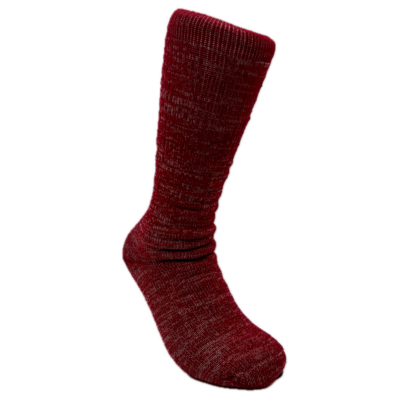
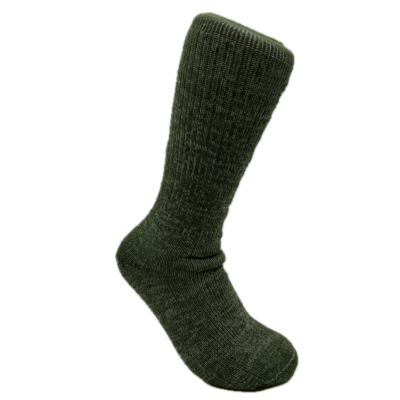
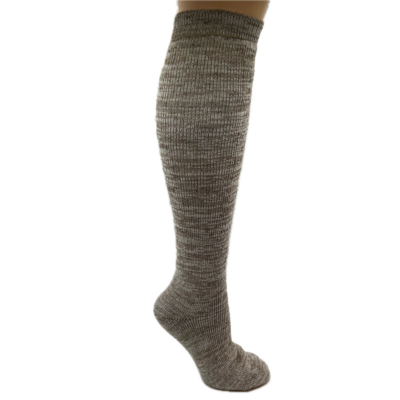

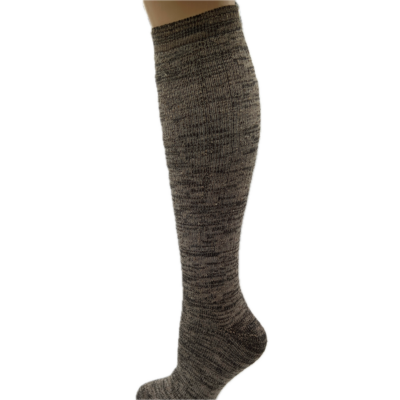
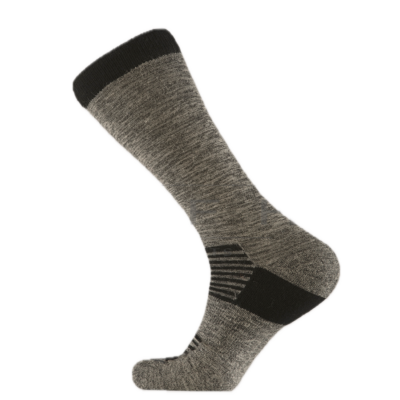
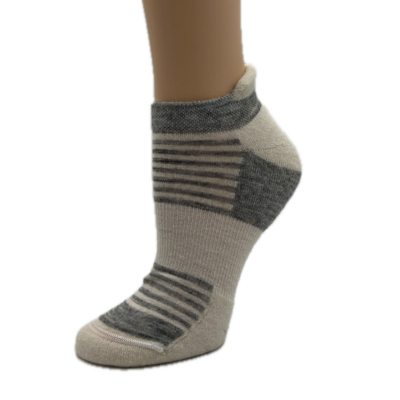
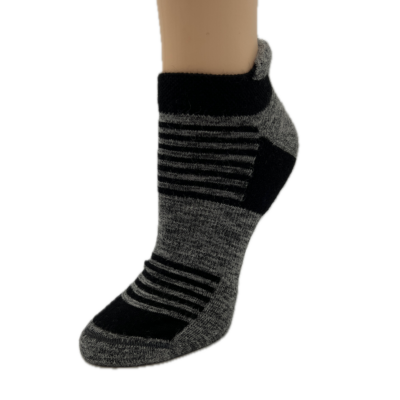
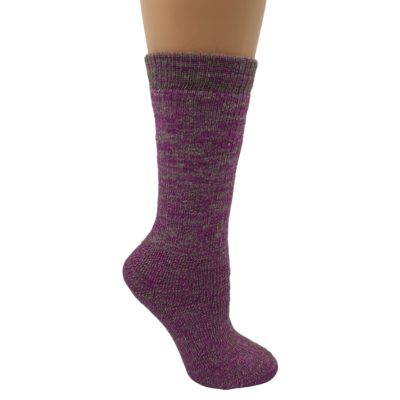
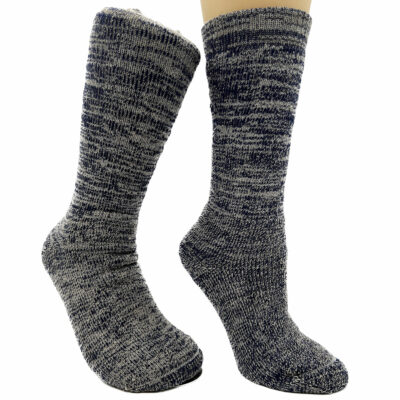
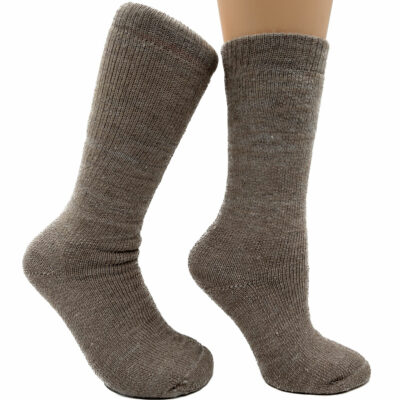

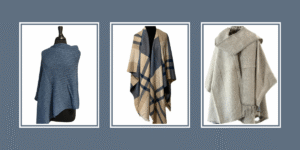

Loved reading this article about alpacas.
Love spinning with the fleece.!
Cute as.
I live in Australia.
I understand that it is not practical to produce 100% alpaca wool socks. What would be a good blend to look for in a heavy sock ?
Lee, you are correct. You’ll rarely find 100% alpaca socks, because they won’t have the ability to keep a secure shape on your feet as you walk. This would also prohibit you from washing them in the washing machine.
Most of our alpaca socks are between 40% – 60% alpaca. I would look for this amount. Anything below that is suspect.
Also, consider the thickness of the sock. Thicker socks will have more alpaca by weight and be warmer, however, they might not fit in everyday shoes of boots.
I find your web site so informative. I cannot decide which ( 3 pair) are for me. I am a “young” 77 year old diabetic lady. I want a medium weight, mid-calf sock. I live in northern WI & have always had cold feet. I am not a winter outside person, just shoveling that white stuff. 😆 looking forward to your response, Victoria D.
Victoria I would recommend the following therapeutic socks based on your desire for half-calf. They will be warm and loose, which would be great for your circulation.
https://cottoncreekfarms.com/store/relaxed-alpaca-socks-in-smokey-grey/
https://cottoncreekfarms.com/store/relaxed-alpaca-socks-in-ivory/
https://cottoncreekfarms.com/store/relaxed-alpaca-socks-in-pink/
MY FIRST APACA SOCKS WERE GREAT AS THEY KEPT MY FEET ABSOLUTELY BRILLIANT AND WARM, DID NOT REALISE THAT THE NEXT 3 PAIR £18 PAIR, WERE NOT THE SAME AS THE FIRST ONES, AND THEN FOUND OUT THEY WERE A MIXTURE OF ALPACA+ FIBRE ( NOT AS WARM BY ANY MEANS) YOU ONLY GET WHAT YOU PAY FOR ( CHEAPS, DEAR!!!)ONLY BUY THE BEST IT’S WORTH IT!!!
I am from Wisconsin and whitetail Hunt up north. I am looking for a good pair of hunting socks to wear in my uggs or my muks. I need something that’s heavyweight and I would guess something with the highest percent of alpaca. What do you recommend?
Lori here are the ones my husband (an avid hunter) would recommend:
https://cottoncreekfarms.com/store/lc231-arctic-knee-high-alpaca-socks-for-extreme-cold-dark-grey/
https://cottoncreekfarms.com/store/alpaca-hiking-socks-in-red/
https://cottoncreekfarms.com/store/unisex-knee-high-alpaca-hunting-socks-in-green/
https://cottoncreekfarms.com/store/michigander-unisex-alpaca-socks-in-brush/
PS: I’ve listed them with the warmest first. Some come in a variety of colors.
I would love your help! I have a wide toe area with arthritis, and cannot wear socks that are tight in the toe/or have prominent toe seams. I’ve given away countless socks due to this. I also have raynauds and live in a ski town. I’m looking for some thick (as warm as possible) below the ankle socks to wear with my slippers, and also a pair of more technical hiking socks (mid calf). I realize both of these may not be available from the same company and that is fine. I appreciate your article – so informative. I’m over my head with my special needs, however.
In the world of alpaca socks, you’d be looking for therapeutic socks. We have these in half calf, but not below the ankle.
Here is a link to all of our therapeutic alpaca socks: https://cottoncreekfarms.com/store/product-tag/therapeutic-alpaca-socks/
Very good and informative article. Thank you for the info.
I have several pair of Alpaca socks, but am interested in getting some of your cold weather (ice fishing and hunting cold) socks.
Vince
If alpaca socks are worn around the house without shoes, they get very “furry” and unpleasant-looking on the bottom. Is this normal?
Laurie my personal experience has been this highly depends on the materials used and the method of washing and drying. Softer alpaca like “baby alpaca” will wear faster than a standard alpaca that is a higher grade. The materials used to mix with alpaca will also influence durability, as will the way you clean it. Socks that are thrown in the dryer will fur more than others that are laid flat to dry.
Our house is all hardwood floors and I don’t get furry alpaca socks. As you might guess, all I wear is alpaca socks. But I’m careful on picking socks with good mixes (like nylon or acrylic mixed in), I wash them on cool water in the machine, then lay them flat to dry.
My husband, on the other hand, wears his in work boots and throws his socks in the dryer. His socks do not last as long as mine do and this is part the wear of his work boots on them and the heat of the dryer.
I find this is true for me and my winter heavier alpaca socks and ankle socks, mainly because of carpeting. I have a simple de-piller, which quickly has them looking new again. The socks that went thru the dryer, pill more easily. They’re washed in cold water and dry flat, and pill much less and not at all if worn in shoes daily.
Rebecca, I was hoping that I could get your thoughts on my “sock needs”. So my needs are they have to be warm, but more importantly they have to be super soft.
In the past, I’ve bought socks online from Amazon. The first pair I bought was advertised as 100% Alpaca. They were perfect; unfortunately, I didn’t really pay attention to the wash & care instructions. I didn’t have a problem with the shape of them, but the fabric started to lose its softness and also developed little balls of fabric inside the sock. I was going to reorder, but I started having problems of them not stocking my size.
I found another pair on Amazon of 100% Alpaca socks. That is when I learned that even if it says 100% Alpaca, the softness was not guaranteed. They felt like they were 100% sheep ‘s wool.
I’m open to trying a sock with mixed fabric, but it’s a deal breaker if they are not really soft. If you can contact me directly to my email address, then I can send you links to the socks I mentioned earlier. I didn’t want to “advertise” the other brands on your website. I would appreciate your feedback. Thank you. Thomas
Thomas except for a few brands I personally know, I have zero trust in the materials listed on Amazon. This is because I see products listed as 100% alpaca on Amazon and I know the products and their source well enough to know they are anything but. A lot of it is mixed with large amounts of acrylic, so you have to be careful with any Amazon purchase. There is just a lot misrepresented.
Keep in mind that the softer (finer) the fiber used to make socks, the faster they will wear and the more delicate they will be in washing. Most of our industry uses grades 3 (superfine) and 4 to make socks so they are durable. Some providers will make them with grade 2 (baby), but this will be more prone to showing wear, felting, and they are much more difficult to wash.
We are working now on creating a therapeutic sock from our fiber and they will use mainly grade 3 for softness, but we are mixing in a little grade 4 and superwashed merino wool to provide more stability for wear and care. Every sock run in our industry is unique because every fiber batch is unique.
In our store, the Mosaic socks are a great everyday sock that is soft and warm. The heavy-weight boot sock in black is made from baby alpaca fiber, so it will be softer than other socks. That is a thicker sock that is meant for outdoor wear.
My recommendation for washing is always use cool water and never put them in the dryer. Even if the label says it is okay, skip the dryer so you can extend the life of your socks. My husband throws everything in the dryer and I can see a huge difference in his socks versus my socks.
Hi- I have a need for socks that provide extreme warmth. Also, they need to cover my leg up to the knee without constricting.
Thank you for your help, Colleen
Colleen does the thickness matter? I can certainly make recommendations on knee high socks, but I want to make sure your boots (if being warn) will have space for a thicker sock.
Hi, my husband purchased the medium crew gray socks for me for my birthday. 1st, very soft comfy socks. Love that. Unfortunately these socks are to big and go up right under my knees. He purchased them for me due to me having Raynauds and we are both hunters as well. We are from Utah and hunt in Utah but my husband also hunts in Nebraska and Kansas during November and December months and will be heading up to Canada hunting next year during the cold snowy months.
So for me I would like to hear your recommendations. I love thick socks, but can not wear thick socks with my regular everyday shoes or boots or my hunting boots. So probably more on the thin to mid weight. I was looking at the no show socks to wear at home with regular shoes/boots or slippers. I always habe socks on now.
Love all the information you provide on your website. I wish all websites had this much detail as yours. I looked forward to hearing back from you.
Thank you,
Sylvia
Sylvia I’m not exactly sure which socks your hubsand bought, so I can’t answer to them specifically.
I can tell you I wear lightweight, thinner socks while inside the house and with my everyday shoes when I leae. I switch to midweight or heavyweight socks for outdoors in winter. The issue here is all midweight and heavyweight socks will be thicker by design and they will need more room in your boot. There is really no getting around that requirement.
In our online store, the “alpaca print socks” will fit in any shoe. They are warmer lightweight socks. Our “Michigander” and “Mosiac” socks are great, but they are midweight and will require a thicker shoe. I love wearing the Michigander and Mosiacs inside the house in winter.
“Relaxed” and “therapeutic” socks are looser, but these are not ideal for those of use with Reynauds. I find the looser fit around my toes isn’t as warm as my bright white toes need. =)
I wear the no shoe socks all summer long. They are great for keeping toes warm and not having a lot of extra material that you wouldn’t want in warmer weather. The “alpaca ankle socks in white and grey” will provide a nice inside wear. I like these year round inside, but will switch to midweight socks in the coldest temps.